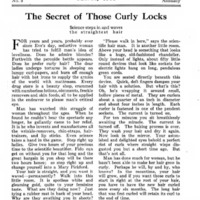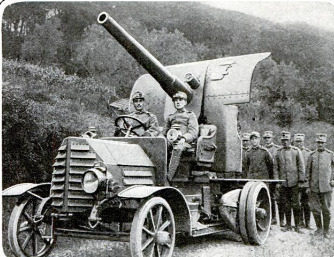Italian anti-aircraft gun
Item
-
Title (Dublin Core)
-
Italian anti-aircraft gun
-
Article Title and/or Image Caption (Dublin Core)
-
Gunning for Aircraft-How the Italians Do It. The pieces must be fired at their targets point-blank, just as a duck hunter fires at birds on the wing
-
Caption: Before the war no military engineer would have dreamt of mounting so heavy a piece on an automobile. Indeed, it would have been considered almost an engineering impossibility. But the necessity of attacking prying air scouts from constantly changing locations has made it absolutely necessary to achieve what seemed to be the impossible
-
extracted text (Extract Text)
-
WHILE it is true that no European
WW strategist foresaw the important
part that aircraft were destined
to play in the present bloody conflict, it
was at least realized that a man in the air
had reconnoitering possibilities. Krupp
even developed anti-aircraft guns to be
carried on automobiles—weapons so clum-
sily mounted that they were of not much
avail against a swiftly moving flying-
machine.
One of Ger-
many’s pio-
neer advo-
cates of the
military fly-
ing machine
was Colonel
Moedebeck.
As far back
as 1909, he
predicted
that only
shrapnel
could be ef-
fectively
used against
a prying air-
scout—a
prediction
which has
been amply
fulfilled in
the war.
How as-
tonishingly
anti-aircraft artillery has developed is
evidenced by the accompanying photo-
graph, taken on the Italian front. The
earlier anti-aircraft weapons were rather
small and were provided with- elaborate
range-finding devices. In a few months it
was found that the pieces must be very
much heavier than had been anticipated,
and that they must fire at their targets,
point-blank, just as a duck hunter fires
at birds on the wing; there is no time for
range finding.
As our photograph shows, the caliber
has been increased enormously. The
English and French have mounted heavy
naval guns on field-carriages. Here we
see an Italian anti-aircraft gun heavier
than the piece which Krupp in 1910 de-
signed exclusively for naval use, boldly
mounted on an automobile truck. It is
evident the truck is built for speed— |
evident because of the mud-guards. |
The heavy shell fired by this Italian |
piece scatters a cloud of deadly
bullets. Because of its power, the
velocity of
the pro-
jectile is
maintained
better than
would have
been possi- L
ble with the
feebler
pieces with
which Eu-
rope entered
the war. In-
deed, high
power is
necessary be-
cause of the
altitude at
which battle
planes now
fly for safety.
Such a
heavy gun
has a practi- 5
cally straight
path at high
angle fire; the projectile reaches its target
quickly. It is hard at best to judge the
point at which an airplane will have
arrived to be annihilated by a shell fired
from below. Hence it is of paramount
importance to reach that point as quickly
as possible.
A good pilot can avoid being hit by
suddenly turning and twisting as soon as
he sees an anti-aircraft battery open
on him. [Established batteries, whose
location can hardly escape detection, are
therefore at a disadvantage. But a gun
like that here shown, mounted as it ison a
swift automobile, has a better chance.
-
Language (Dublin Core)
-
eng
-
Date Issued (Dublin Core)
-
1918-03
-
pages (Bibliographic Ontology)
-
419
-
Rights (Dublin Core)
-
Public Domain (Google digitized)
-
References (Dublin Core)
-
Europe
-
Archived by (Dublin Core)
-
Filippo Valle
-
Alberto Bordignon (Supervisor)
 Popular Science Monthly, v. 92, n. 3, 1918
Popular Science Monthly, v. 92, n. 3, 1918



